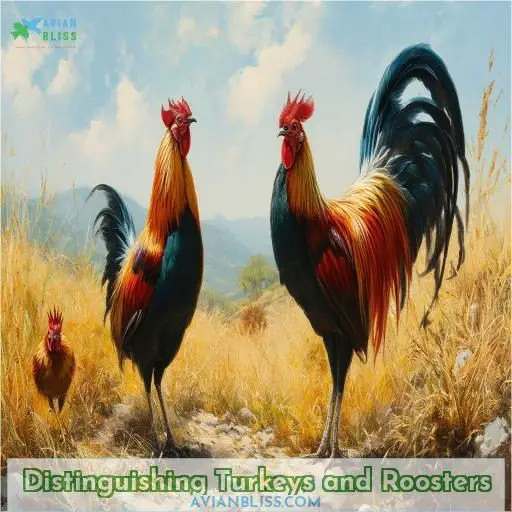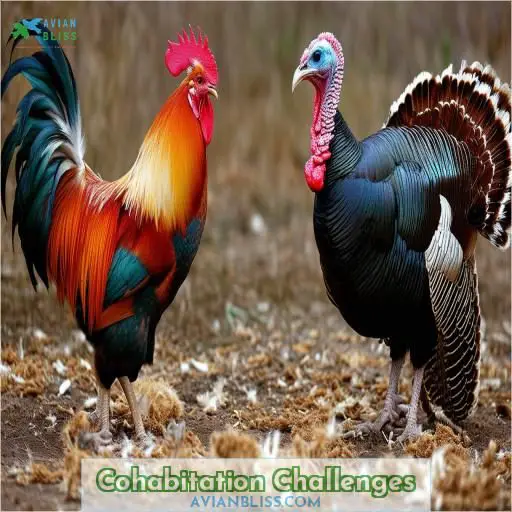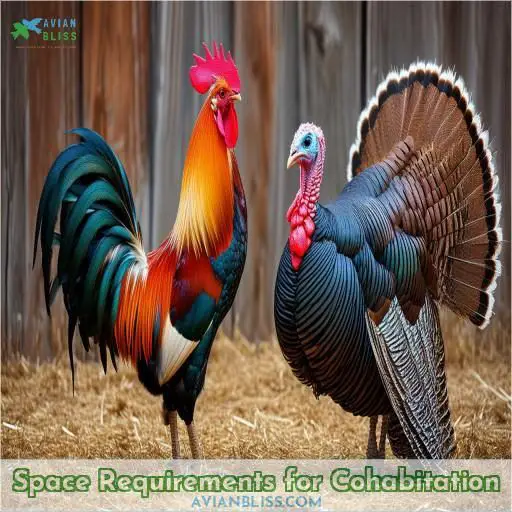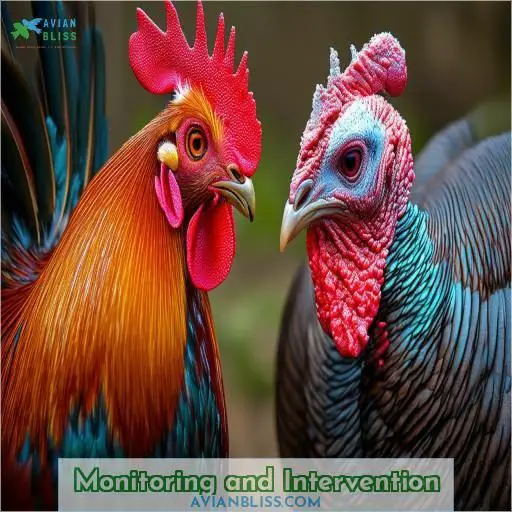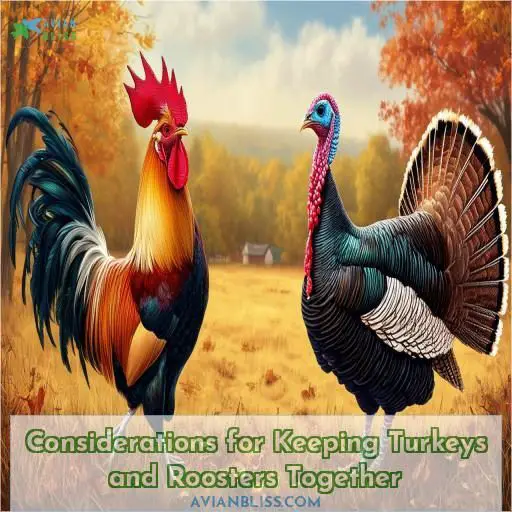This site is supported by our readers. We may earn a commission, at no cost to you, if you purchase through links.

Imagine a territorial tom turkey asserting his reign over your prized rooster, chasing and flogging him relentlessly. Their mating behaviors also pose risks, with toms potentially attempting to mate with your hens, leading to injuries or undesired interbreeding.
To mitigate conflicts, you’ll need ample space, separate quarters, and a watchful eye to intervene when necessary. But with proper planning, you might just witness an unusual harmony unfold between these feathered companions.
Table Of Contents
- Key Takeaways
- Distinguishing Turkeys and Roosters
- Cohabitation Challenges
- Space Requirements for Cohabitation
- Monitoring and Intervention
- Considerations for Keeping Turkeys and Roosters Together
- Frequently Asked Questions (FAQs)
- Is rooster the same as turkey?
- Is a male turkey called a rooster?
- Can you tell the difference between turkey and chicken?
- Can a rooster breed a turkey?
- How do turkey and rooster mating behaviors differ?
- What precautions prevent injuries during turkey-rooster interactions?
- At what ages can turkeys and roosters coexist?
- How do flock dynamics change with mixed species?
- Conclusion
Key Takeaways
- Brace yourself for an epic clash of the feathered titans! These majestic birds have distinct physical and behavioral differences that can lead to some serious poultry pandemonium if not managed properly.
- Imagine a territorial tom turkey asserting his reign over your prized rooster, chasing and flogging him relentlessly. It’s like a scene straight out of Game of Thrones, but with feathers instead of swords.
- Proper planning is key to avoiding injuries and unwanted interbreeding. You’ll need ample space, hiding spots, and separate quarters for these feathered companions to establish their own territories and pecking orders.
- With patience, observation, and a keen understanding of their social dynamics, you might just witness an unusual harmony unfold between these feathered warriors. Or, you might end up with a backyard version of the Trojan War – it’s a gamble, but one that could be worth taking for true poultry enthusiasts!
Distinguishing Turkeys and Roosters
Turkeys and roosters are easily distinguished by their physical characteristics.
Turkeys are much larger, with fleshy wattles and elongated snoods over their beaks.
Roosters have pointed combs atop their heads, long arching tails, and sharp spurs on their legs.
Their behaviors also vary considerably.
Turkeys are typically more docile unless challenged.
Roosters tend to be more aggressive in establishing and defending their territory and dominance over the flock.
Physical Differences
Distinguishing turkeys and roosters is important for proper coop design. Here are key physical differences:
- Turkeys are larger, with featherless heads and wattles
- Roosters have feathered heads, combs, and smaller wattles
- Male turkeys have distinctive snoods and larger beaks
- Hens lay more eggs than female turkeys
Understanding these visuals aids in identifying males for mating rituals and ensuring separate quarters if needed.
Behavioral Differences
Unlike roosters who establish a pecking order, turkeys have a strong social hierarchy where the tom is dominant. You’ll notice:
- Turkeys are less vocal than roosters
- Toms are more territorial and aggressive
- Hens are solitary breeders
These behavioral differences, along with breed incompatibility, can create communication barriers and conflict when housing turkeys and roosters together in the same run.
Cohabitation Challenges
When keeping turkeys and roosters together, you’ll need to closely monitor their interactions, as aggression and dominance struggles can arise. Breeding behavior may also pose challenges, with turkeys potentially injuring or attempting to mate with chickens, necessitating separation in some cases.
Aggression and Dominance
One major cohabitation challenge is aggression and dominance displays. Male turkeys assert dominance, often:
- Confronting roosters in the roost or pen
- Chasing roosters through gates to separate quarters
- Flogging roosters with wings until they submit
Monitoring flock dynamics is essential to prevent severe injury from dominance behaviors and resource competition.
Breeding and Mating
During breeding season, toms may attempt to mate with your chicken hens, leading to:
- Crushed or injured hens
- Territorial turkeys attacking broody hens
- Interbreeding between species
- Videos of heartbreaking rooster vs. turkey battles
Separating flocks or allowing alternating free range may prevent this poultry pandemonium. Consider yourself warned.
Space Requirements for Cohabitation
If you plan to house turkeys and roosters together, providing ample space is essential for their cohabitation. Ideally, you’ll need a spacious poultry yard, at least 150 feet by 600 feet, with hiding spots like trees, brush, and sheds to allow the birds to avoid conflicts and establish separate territories or quarters when required.
Adequate Space
After establishing the challenges of cohabitation, it’s essential to provide adequate space to prevent conflicts. You’ll need:
- A spacious poultry yard, at least 150ft x 600ft
- Trees, brush, and sheds for hiding areas
- Sufficient space to avoid overcrowding
- Separate areas to prevent interbreeding
- Compatibility between birds to minimize aggression
Separate Quarters
While a spacious, open-plan yard is ideal, you’ll often need to provide separate quarters for turkeys and roosters. This allows each group to establish their own hierarchy and feeding routine without interference. Consider:
- Dedicated pens or coops for each species
- Rotating access to shared spaces
- Partitioned areas for roosting and nesting
- Strategic placement of shelters and feeders
- Secure, predator-proof night housing
Monitoring and Intervention
As the caretaker of a mixed flock, you’ll need to closely monitor the interactions between turkeys and roosters, as they can quickly escalate into aggressive confrontations. Recognize signs of tolerance, such as coexisting peacefully in shared spaces, and intervene swiftly if prolonged conflicts arise, separating the birds if necessary to prevent potential injuries.
Observing Interactions
When introducing turkeys and roosters, closely monitor their interactions. Watch for 1) aggressive posturing, 2) pecking or chasing behaviors, 3) injuries from conflicts, and 4) signs of stress like feather-pulling. Intervene swiftly to prevent escalating aggression by separating them temporarily until tensions subside.
Tolerance and Coexistence
With patience and observation, you’ll learn if coexistence is possible:
- Social hierarchy may establish peace between birds
- Shared resources like food/water access reduce conflicts
- Territorial disputes subside as boundaries form
- Seasonal aggression wanes after mating periods
- Mating interference decreases as roles cement
If tensions persist despite preventive measures, separating flocks is wise to avoid injury.
Considerations for Keeping Turkeys and Roosters Together
When contemplating keeping turkeys and roosters together, it’s imperative to evaluate their compatibility and determine if separation into distinct flocks is necessary. While some roosters may coexist peacefully with turkeys, others might exhibit aggressive behavior, requiring physical barriers to prevent conflicts and potential injuries.
Compatibility
Compatibility hinges on understanding each bird’s social hierarchy and pecking order. Factors like:
- Territorial disputes over resources
- Dominance displays and interspecies relationships
- Individual temperaments and aggression levels
- Available space for establishing boundaries
Observing interactions is essential to determine if cohabitation fosters a peaceful dynamic or constant conflict.
Separate Flocks
While cohabitation can be done, you may want to explore keeping turkeys and roosters in separate flocks to avoid:
- Injuries from aggression and mating attempts
- Unwanted interbreeding
- Competition for resources and territory
- Disruption of your selective breeding programs
- Constant monitoring and intervention requirements
Frequently Asked Questions (FAQs)
Is rooster the same as turkey?
Did you know roosters belong to the Phasianidae family, while turkeys are part of the Meleagridae family? Despite their avian similarities, these two fowl species have distinct biological differences. As an aviculturist, understanding their taxonomy is essential for proper husbandry.
Is a male turkey called a rooster?
No, a male turkey is called a "tom" or "gobbler," while a rooster refers to a male chicken. Though both birds, they’re distinct species with different names for their genders.
Can you tell the difference between turkey and chicken?
With 27 bones compared to a chicken’s 92, the turkey’s wingspan can exceed 6 feet. You can easily differentiate them: turkeys strut with a distinctive wattle and snood, while chickens have smaller combs and wattles.
Can a rooster breed a turkey?
While theoretically possible through artificial insemination, turkeys and chickens can’t naturally breed due to physiological incompatibilities between the species.
How do turkey and rooster mating behaviors differ?
Tired of watching birds mate in boring ways? Turkey toms are the UFC fighters of mating – they’ll practically pulverize a hen before breeding her. Roosters, though? More of a courtship dance, if you catch my drift. Who knew bird sex could be so intense
What precautions prevent injuries during turkey-rooster interactions?
You’ll need ample space, hiding spots, and prepared separation areas. Monitor interactions closely; intervene promptly if conflicts arise. Consider permanent separation if persistent aggression occurs to prevent severe injuries.
At what ages can turkeys and roosters coexist?
You can safely introduce turkeys and roosters when juveniles (4-6 months old). Mature birds often fight for dominance, leading to injuries. Monitor interactions closely, provide ample space, and separate aggressors if needed.
How do flock dynamics change with mixed species?
You’ll witness epic battles for dominance that would make Sparta blush! Turkeys and chickens create dynamic hierarchies, with constant power struggles and drama worthy of reality TV. Brace yourself for feathery fireworks in mixed flocks!
Conclusion
Ultimately, whether you opt for roosters vs turkeys or a combined flock depends on your space, resources, and commitment to vigilance. Proper planning, separate quarters, and close monitoring during interactions minimize risks from aggression and unwanted breeding. With patience and the right setup, these majestic birds can potentially coexist harmoniously in your backyard sanctuary.

